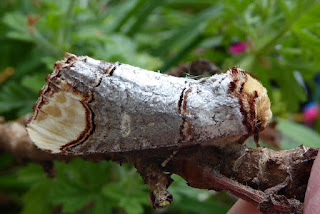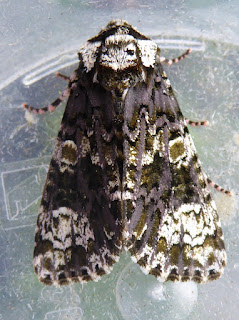I actually managed to get the mothbox out in the backyard twice in a week (July 7th and 9th) and I had small but varied catches with the highlights being buff tip, buff arches and marbled green along with heart and club, lime speck pug, flame, scalloped oak, yellow barred brindle and dark arches.
Marbled Green, Back Yard
July 10th and it was off to stay at the caravan at Bude for my birthday, highly likely to be for the last time as the out-laws will probably sell it at the end of this season. The weather forecast wasn't looking too good for the week and it was quite a mixed bag with cloud, mist, drizzle, occassional showers, sunny spells and all with a cold and brisk north westerly wind.
The toilet blocks on the camp site came up trumps despite my worries that the new lighting wouldn't be any good for moths and in the mornings I managed to find riband wave, wormwood pug, fan foot, single dotted wave, brimstone moth, smoky wainscot, snout, v pug, lackey, small rivulet, mottled rustic, scalloped oak, buff arches, Aethens rubigana and a male bordered beauty.
Bordered Beauty (male), Bude - a new moth for me
I had the moth box out on a few nights later in the week when the wind had eased and night time temperatures were higher and caught a decent range of moths, highlights being garden tiger moths, a poplar hawkmoth, crescent dart, peppered moth, dark sword grass, plain golden y, silver y, sandy carpet, common emerald, grass emerald, barred straw, Devonshire wainscot, swallowtail moth, dot moth, clay, July belle, common wainscot and double square spot.
July Belle, Bude
Lackey
Crescent Dart
Mottled Rustic - another new moth for me (but probably overlooked!)
Poplar Hawkmoth close-up
Small Magpie
Riband Wave - form remutata
Riband Wave
Devonshire Wainscot (left) with Common Wainscots
Garden Tiger Moth - each moth has different markings (like fingerprints)
Garden Tiger Moth - number 2
Garden Tiger Moth - number 3
The water levels in Maer Lake were very low with lots of mud on show and maximum counts for the week were 7 black tailed godwits in summer plumage, 3 dunlin in summer plumage, 2 redshank, a whimbrel heard only, a curlew heard only, a grey heron and 4 Mediterranean gull (2 adults in summer plumage and 2 2nd summers).
Black Tailed Godwit, Maer Lake
Comma, Maer Lake
Male Stickleback, Crooklets Beach, Bude
#
Rabbit, Campsite
Offshore there was little on show in the choppy seas with viewing hampered by the strong winds but I did find 2 adult gannets and a dark looking peregrine unsuccessfully stooping at a small flock of black headed gulls out at sea. 2 fulmars were along the cliffs and 4 oystercatchers were seen roosting on the pebble beach at high tide.
July 12th and we took a trip to Hartland Abbey, about 14 miles north along the coast from Bude and somewhere we haven't visited before. It was grey and breezey on arrival but the sun did eventually shine and I saw my first gatekeeper of the year along with brief fly past views of 2 silver washed fritillaries.
Gatekeeper, Hartland Abbey
The Abbey was very interesting, still lived in by the family and with a lovely homely atmosphere quite unlike the overly corporatness of National Trust houses. The walled garden was beautiful, the best I have ever visited, and while wandering around the flowers and vegetables I heard a tawny owl and a very noisey juvenile buzzard. The tea room was really good too and we had a lovely lunch sat outside in the sunshine.
Hartland Abbey - Walled Garden
Fledgling Robin, Hartland Abbey
After visiting the Abbey we headed to nearby Hartland Quay which was very interesting too and we had a walk along the coast path to have a look at 2 waterfalls tumbling over the high cliffs. I managed to pick up my first tick of the year on the back of my knee but more interesting were 3 fledgling wheatears, a small copper, a hovering kestrel and 2 or 3 peregrines flying about overhead.
Hartland Quay Waterfall
Fledgling Wheatear, Hartland Quay
July 14th and we also took a trip again to the nearby Dunsdon nature reserve on what was the warmest and sunniest day of the week. We visited Dunsdon in 2013 on a baking hot and sunny day and walked along the aqueduct trail by the Bude canal to Burmsdon aqueduct and back. This time we walked the trail from Dunsdon to Upper Tamar Lake and back and it was just as interesting and wildlife filled. The highlights were a reeling grasshopper warbler which I couldn't locate, lots of heath spotted orchids, plenty of butterflies (marbled whites, ringlets, meadow browns, large skippers and small skippers), silver y and 6 spot burnet moths, a singing reed bunting and a male black tailed skimmer, a common sandpiper heard calling and 2 great crested grebes at Lower Tamar Lake.
Heath Spotted Orchid, Dunsdon
Heath Spotted Orchid and Meadow Brown
Ringlet
Male Black Tailed Skimmer, Lower Tamar Lake
I wanted to see lesser butterfly orchid again but the field where I had seen one before had recently been grazed by cattle and I could only find a few heath spotted orchids amongst the cropped vegetation and cow pats. I kept my eyes open but couldn't find one in the other fields either but walking back to the car park at the end of the walk and I found one just by the footpath which was very nice to see.
Lesser Butterfly Orchid, Dunsdon
Lesser Butterfly Orchid
Lesser Butterfly Orchid
Lesser Butterfly Orchid
So all in all not a bad week away despite the less than ideal weather conditions and maybe a nice swansong to our trips to Bude.







































































